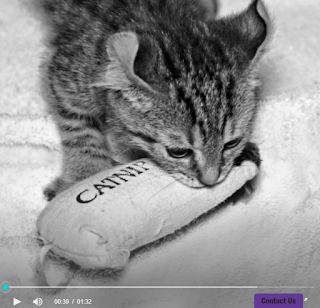The Cat’s Meow: What’s my cat really trying to say?
If you own a cat, you already know that your feline friend has a very large vocabulary. Chirps and trills, meows and yowls, purring or hissing, or just an intent, silent stare are all part of your cat’s vocal communication. And that doesn’t even scratch the surface of the visual cues your cat is giving you.
Amongst themselves, cats communicate by sound, body language, and smell. For us humans, however, we’re more attuned to the vocal cues and the more obvious visual cues while the scent cues are completely lost on us. For this reason, it seems that cats use meows most often when communicating with humans.
Another reason why cats meow at us could relate back to each cat’s experience as a newborn kitten. Kittens are blind and deaf when they’re first born, yet they still meow to alert their mothers of their presence and needs. When we become the cat’s primary caretaker, the all-around distributor of food and love, the cat’s tendency to meow probably becomes directed at us.
Cats have common patterns of communication (as outlined below) but you could also say that each cat has its own “dialect” or unique way of communicating. You help build this dialect as you communicate back to your pet and give her what she wants. Rewards usually reinforce certain behaviors, so if your cat does a funny trill and you laugh and give her love and affection, odds are she’ll keep that trill in her vocabulary. Similarly, if you respond to a meow by giving your cat food, or opening a door, or doing whatever it is she wants you to do, you’re helping your cat to create a code of behaviors and meows that allow her to communicate with you.
When listening to the sounds your cat makes, also pay attention to the context and the body language of your cat. If you’re just walking in the door and your cat meows at you with her tail and ears up, that’s probably a friendly hello. If you find your cat crouched in a corner, ears flat, tail wrapped protectively around her, and she’s making a low, growling meow, she’s probably letting you know she’s feeling threatened and is not interested in your company right now.
Here’s a basic break down of kitty communication:
The All-Purpose Meow
Hello, I’m here, I want food, please pet me, open this door, let me in there… The many meanings of the meow could go on and on. A meow alone won’t tell you much. Pay attention to your cat’s tail, ears, position, and intent. Is she rubbing against your leg or is she on the other side of the room, half-way out the door, trying to get you to follow? Does she seem happy, scared, sad, lonely? Sometimes kitty just wants to get your attention, and for that, a meow is perfect.
Purring
This throaty rumble is a sign of contentment and happiness. It can be communicative, meaning your cat wants you to know she’s happy, but it is also just comforting for kitty. In some cases, cats will actually use purring to comfort themselves if they are sick.
Chirps or Trills
You’ll notice that mama cats use trills to communicate with their kittens. It may signal that the cat wants you to follow or do something. Humans often interpret trills as questions because they end on an up note. Trills can also mark confusion or frustration. Watch your cat to see if she seems to be waiting for something from you. Who knows, maybe she is just asking where you’ve been.
C:
This is a very recognizable vocalization that primarily shows up when your kitty is bird or squirrel watching at the window. It looks like an almost knee-jerk reaction of the kitty’s jaw, and some suggest that it’s a mark of frustration or anticipation of the cat wanting to catch what she is seeing outside.
Growling
A cat’s growl sounds like a deep, drawn out, gutteral meow. The mildest type of growl simply expresses displeasure. For example, if you’re holding a cat that simply doesn’t want to be held, she will make a long, deep, growl or whine but will not lay the ears back or seem intent on striking out. Still, it’s wise to respect this growl and give the kitty her space. Other growls come out of an awareness of danger that the cat perceives, either for herself or for someone else. Cats are not as people protective as dogs, but they still have those protective instincts. If you hear your cat growling, it’s best to look at her and figure out what is threatening her or someone around her.
Hissing
This clear signal, whether directed at another cat or at a person, always means, “Back off.”
Yowling or Caterwauling
Loud, drawn out, and repetitive yowling is a female cat’s mating call. This call is distinctive from the more frantic yowling of a cat in distress.
It’s important to note that a sudden change in your cat’s meowing and body language patterns can indicate a change in her health. If you’re aware, your cat can let you know if she’s sick or in pain. Cats also use meowing to express a change in mood. If you bring a new kitten into your home, it may spend the first few nights loudly meowing because it’s looking for its mom and it’s confused by its new surroundings.
Take the time to get to know your cat’s meow. You’ll be surprised to find just how well you can understand your feline friend.
See more at - https://www.2pawsupinc.com




Comments
Post a Comment